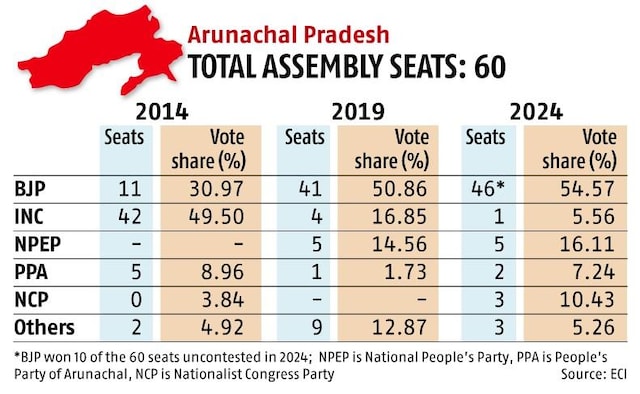Arunachal Pradesh election results: There is no party for BJP and Khandu
Arunachal Pradesh CM Pema Khandu (left) with BJP leader and party president Ashok Singhal in Itanagar on Sunday (Photo: PTI)
The Bharatiya Janata Party (BJP) has retained power in Arunachal Pradesh by emerging victorious in the Assembly elections by securing 46 of the total 60 seats. The party won 10 seats uncontested.
After the counting of votes on Sunday, the BJP not only improved its score from the 41 seats it won in 2019, but also saw an increase in its vote share from 51 percent to 54.57 percent.
Chief Minister Pema Khandu, who won the Mukto seat, was among the ten BJP candidates who won unopposed. The other uncontested seats were Itanagar, Bomdila, Chowkham, Hayuliang, Roing, Sagalee, Tali, Taliha and Ziro Hapoli. The remaining 50 seats, along with the two Lok Sabha seats from Arunachal, went to polls on April 19.
This victory marks the BJP’s third consecutive term in the northeastern state. The party first came to power in the state in December 2016 when 33 legislators from the Arunachal People’s Party (PPA), led by Khandu, joined the BJP. The 43 PPA lawmakers had earlier broken away from the then ruling Congress.

Of the 50 seats contested, the BJP won 36. The National People’s Party (NPEP), the Conrad Sangma-led ruling party of Meghalaya, emerged as the second largest party, winning five seats and securing a vote share of 16.11 per cent. The candidates were runner-ups in 13 seats.
The Nationalist Congress Party (NCP), despite losing its “national party” status last year, won three seats and a vote share of 10.43 percent. The Congress managed to win only one seat while the PPA won two.
Addressing X, Prime Minister Narendra Modi thanked the people of Arunachal Pradesh. “The people of this beautiful state have given an unequivocal mandate to the politics of development… Our party will continue to work with even greater vigor for the growth of the state,” he wrote.
Arunachal Pradesh is the largest state in the northeast with an area of 83,743 km² (2.5 percent of India’s land area). The state also has a higher per capita income than that at the national level.
Over the past nine years, per capita income in the state has been between 18 and 43 percent higher than the all-India level. Even then, the percentage of the population living under multidimensional poverty is only a tad lower than the all-India level. On the contrary, the urban population had slightly more people in multidimensional poverty (5.9 percent) than 5.27 percent at the all-India level in 2019-2021.
Nearly 77 percent of the population lives in rural areas, where 15.14 percent of people faced multidimensional poverty, compared to 19.28 percent nationally in 2019-2021.
Like other northeastern states, Arunachal Pradesh is overly dependent on central subsidies and its share of the divisible pool of union taxes for its resources. Its own tax revenues have never reached 13 percent of revenues in the past ten years. The state did not publish regular inflation data for urban areas. In rural areas, inflation has been much better controlled in recent months than at national level. Retail inflation was just 3.1 percent in villages compared to 5.6 percent in rural India in the first eleven months of the current financial year. Inflation in food and beverages was only 1.39 percent in rural Arunachal Pradesh in April-February of FY24, compared to 6.8 percent in rural India.
At the age of 45, Pema Khandu has already become the second-longest serving chief minister of Arunachal Pradesh, surpassed only by Gegong Apang, who held the post for almost 23 years. His father, Dorjee Khandu, was chief minister for four years before he was killed in a helicopter crash in April 2011.
Khandu entered the political arena in 2000 and joined the Congress. After his father’s death, he ran for the Assembly from Mukto, his father’s constituency. He was Minister of Tourism in Nabam Tuki’s Congress government. However, his political trajectory took a sharp turn after a constitutional crisis in January 2016, which resulted in the imposition of presidential rule.
When it was dissolved, Khandu found himself serving as a minister in the short-lived government led by Kalikho Pul, which was externally supported by the BJP. The Supreme Court intervened and restored the Tuki government. Tuki soon resigned and Khandu, then 37, rose to become prime minister in July 2016. In a surprise move, Khandu, along with 42 other Congress legislators, defected to the Arunachal People’s Party (PPA) in September. In December 2016, Khandu had led 33 MLAs to join the BJP. Under his leadership, the BJP was victorious in the Assembly elections held concurrently with the 2019 Lok Sabha polls, also securing both the Lok Sabha seats in the state.
As Khandu indicates on his ‘X’ handle, he is an alumnus of Delhi’s Hindu College. Known for his love for sports and music, he often delights attendees at official functions with renditions of classics by Kishore Kumar and Mohammad Rafi. He has promoted traditional songs through talent shows in Tawang and West Kameng districts.
(With inputs from Indivjal Dhasmana)
First print: June 2, 2024 | 11:00 PM IST
